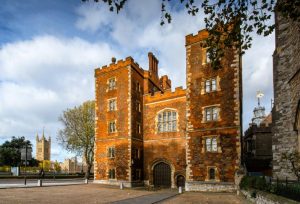
For nearly 800 years, Lambeth Palace has been the London residence of the Archbishop of Canterbury. Originally called the Manor of Lambeth, or Lambeth House, the site was acquired around AD 1200 and it contains a very important library of church documents.
The Lambeth Palace Conservation Area Character Appraisal, 2017 says:
‘The Lambeth Palace Conservation Area has at its heart the Archbishop of Canterbury’s Official Residence – Lambeth Palace, the principal ancient monument of Lambeth.’
‘As the official seat of the Archbishop of Canterbury Lambeth Palace represents “Church” and as the seat of government the Palace of Westminster represents “State”; this is exceptionally important to London and to the nation. Lambeth Palace is a complex of great significance both architecturally and historically; it contains elements dating from the early 12th century and still has a strong constitutional and physical relationship with the Palace of Westminster. This relationship has significantly influenced the development of the area over the centuries and many local buildings and projects have carried a connection with the Palace or former Archbishops of Canterbury.’
‘Conservation area designation brings with it additional planning controls, control over demolition and the protection of trees. Section 72 of the Act places a duty on the council and other decision makers to special attention in the exercise of planning functions to the desirability of preserving or enhancing the character or appearance of conservation areas. This includes exercising control over development proposals that are outside the conservation area but would affect its setting, or views into or out of the area.’
‘The close proximity of the Westminster World Heritage Site and its historic connections to Lambeth Palace is a significant consideration in planning for the conservation area.’
Furthermore:
‘The historic and visual relationship between Lambeth Palace and the WWHS is a significant one. The conservation area also sits within the “approaches” – the important areas of public realm leading to it.’
‘The former St Mary’s Church (the fourteenth-century tower is Lambeth’s oldest) with its charming historic churchyard and the exceptional contribution made by the other open spaces create an exceptional place in the heart of the city.’
